Therapeutic Effect of Novel Cyanopyrrolidine-Based Prolyl Oligopeptidase Inhibitors in Rat Models of Amnesia
- PMID: 35004610
- PMCID: PMC8727363
- DOI: 10.3389/fchem.2021.780958
Therapeutic Effect of Novel Cyanopyrrolidine-Based Prolyl Oligopeptidase Inhibitors in Rat Models of Amnesia
Abstract
Prolyl oligopeptidase (POP) is a large cytosolic serine peptidase that is altered in patients with Alzheimer's disease, Parkinsonian syndrome, muscular dystrophies, and other denervating diseases. Thus, POP may represent a relevant therapeutic target for treatment of neuropsychiatric disorders and neurodegenerative diseases. Here, we report the characterization of five novel cyanopyrrolidine-based compounds (BocTrpPrdN, BocGlyPrdN, CbzMetPrdN, CbzGlnPrdN, and CbzAlaPrdN) and show that they are potent inhibitors of POP and are predicted to penetrate the blood-brain barrier (BBB). Indeed, we show that CbzMetPrdN penetrates the rat BBB and effectively inhibits POP in the brain when administered intraperitoneally. Furthermore, molecular modeling confirmed these compounds likely inhibit POP via interaction with the POP catalytic site. We evaluated protective effects of the cyanopyrrolidine-based POP inhibitors using scopolamine- and maximal electroshock-induced models of amnesia in rats and showed that BocTrpPrdN, BocGlyPrdN, CbzMetPrdN, and CbzGlnPrdN significantly prolonged conditioned passive avoidance reflex (CPAR) retention time when administered intraperitoneally (1 and 2 mg/kg) before evaluation in both models of amnesia, although CbzAlaPrdN was not effective in scopolamine-induced amnesia. Our data support previous reports on the antiamnesic effects of prolinal-based POP inhibitors and indicate an important role of POP in the regulation of learning and memory processes in the CNS.
Keywords: Alzheheimer’s disease; antiamnesic activity; blood brain barrier; brain; conditioned passive avoidance reflex; cyanopyrrolidine derivatives; prolyl oligopeptdases.
Copyright © 2021 Zolotov, Schepetkin, Voronina, Pozdnev, Khlebnikov, Krylova and Quinn.
Conflict of interest statement
The authors declare that the research was conducted in the absence of any commercial or financial relationships that could be construed as a potential conflict of interest.
Figures
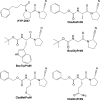

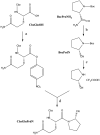

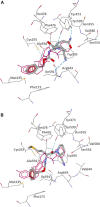
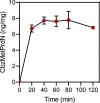
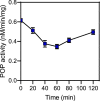


Similar articles
-
Low molecular weight inhibitors of Prolyl Oligopeptidase: a review of compounds patented from 2003 to 2010.Expert Opin Ther Pat. 2011 Jul;21(7):1023-44. doi: 10.1517/13543776.2011.577416. Epub 2011 May 3. Expert Opin Ther Pat. 2011. PMID: 21539473 Review.
-
Prolyl oligopeptidase: a potential target for the treatment of cognitive disorders.Drug News Perspect. 2007 Jun;20(5):293-305. doi: 10.1358/dnp.2007.20.5.1120216. Drug News Perspect. 2007. PMID: 17878957 Review.
-
Prolyl oligopeptidase and its role in the organism: attention to the most promising and clinically relevant inhibitors.Future Med Chem. 2017 Jun;9(10):1015-1038. doi: 10.4155/fmc-2017-0030. Epub 2017 Jun 20. Future Med Chem. 2017. PMID: 28632451 Review.
-
Beneficial effect of prolyl oligopeptidase inhibition on spatial memory in young but not in old scopolamine-treated rats.Basic Clin Pharmacol Toxicol. 2007 Feb;100(2):132-8. doi: 10.1111/j.1742-7843.2006.00021.x. Basic Clin Pharmacol Toxicol. 2007. PMID: 17244263
-
Specific inhibitors for prolyl endopeptidase and their anti-amnesic effect.J Pharmacobiodyn. 1987 Dec;10(12):730-5. doi: 10.1248/bpb1978.10.730. J Pharmacobiodyn. 1987. PMID: 3330562
Cited by
-
Proteomic Analysis Reveals Differential Protein Expression Induced by Inhibition of Prolyl Oligopeptidase in Filarial Parasites.Protein J. 2022 Dec;41(6):613-624. doi: 10.1007/s10930-022-10080-7. Epub 2022 Oct 22. Protein J. 2022. PMID: 36271977
-
Neuroinflammatory Response and Redox-regulation Activity of Hyperoside in Manganese-induced Neurotoxicity Model of Wistar Rats.Curr Aging Sci. 2024;17(3):220-236. doi: 10.2174/0118746098277166231204103616. Curr Aging Sci. 2024. PMID: 38500281
References
-
- Ader R., Weijnen J. A. W. M., Moleman P. (1972). Retention of a Passive Avoidance Response as a Function of the Intensity and Duration of Electric Shock. Psychon. Sci. 26 (3), 125–128. 10.3758/bf03335453 - DOI
LinkOut - more resources
Full Text Sources

